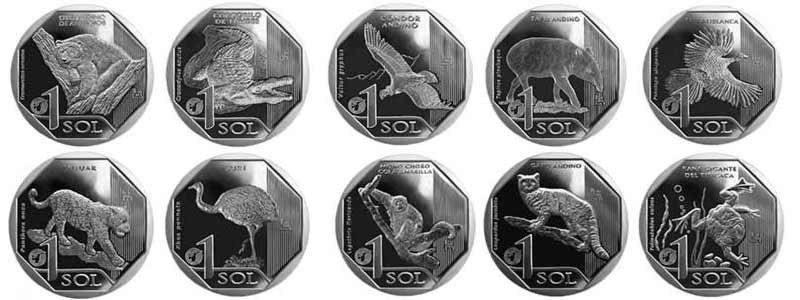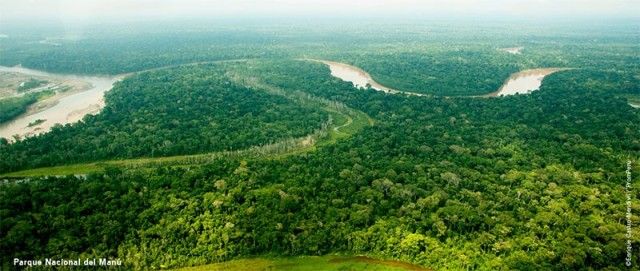The numismatic series "Fauna Silvestre Amenazada del Perú" (Threatened Wildlife of Peru) was issued by the Peruvian Central Reserve Bank (BCRP) to continue with the lovely numismatic culture and to raise awareness for the importance of species and environment protection with one of the most commonly used coins in the country, the S/ 1 coin.
On the front of each of the 10 different Threatened Wildlife coins one native animal in Peru threatened with extinction is depicted; the back shows the Peruvian Coat of Arms surrounded by the writing Banco Central de Reserva del Perú (Central Reserve Bank of Peru) and the year of issue.
All coins in the series have the denomination of One Sol (S/ 1). They are legal tender. The coins circulate simultaneously with all other S/ 1 coins and can be used in any transaction in Peru. 10 million units from each motive have been minted.
Specifications
- Value: One Sol (S/ 1)
- Date of issue: between 2017 and 2019
- Diameter: 25.5 mm
- Mass: 7.32g
- Material: Alpaca (copper alloy with nickel and zinc)
- Mintage: 10 million coins of each motive
- Front image: native animal threatened with extinction and the logo of the National Mint on a background of vertical lines.
- Back image: Peruvian Coat of Arms
- Legal tender: Yes
1st Threatened Wildlife coin - Andean Spectacled Bear (Oso Andino de Anteojos)
The first coin of the Threatened Wildlife numismatic series was issued on July 18, 2017. It features the Andean spectacled bear (tremarctos ornatus), also known as the Andean bear, Andean short-faced bear or in Peru Jukumari.
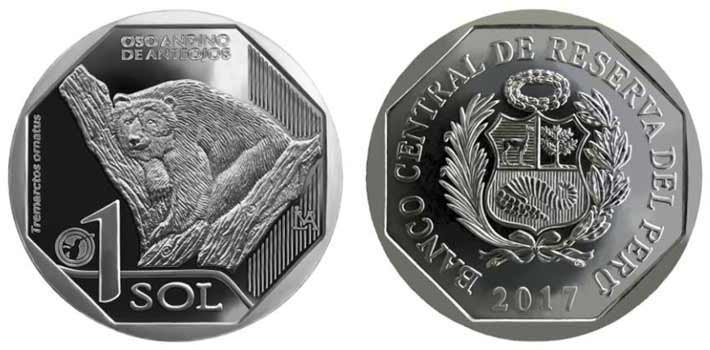
The front of the new S/ 1 coin shows a spectacled bear laying on a tree. As only bear native to South America, the spectacled bear mainly lives in the Andes Mountains of Ecuador, Colombia, Bolivia and Peru in humid and cooler areas. The mid-sized Andean bear has a blackish-brownish fur and distinctive whitish-beige to light brown spectacle-like markings around the eyes and across the face and chest. The usually shy and solitary Andean spectacled bear spends much of its time climbing trees and feeding on vegetation such as cactus, palm nuts and leaves, bamboo, orchids and fruits; only about 5% of their diet is meat.
With only 18,000 spectacled bears left on our planet, from which about a third live in Peru, the Andean short-faced bear is considered vulnerable according to the IUCN (International Union for Conservation of Nature) Red List of Threatened Species. Principal threats include habitat loss because of agriculture, illegal logging, mining, oil exploration and road development, and poaching.
2nd Threatened Wildlife coin - Tumbes crocodile (crocodrilo de Tumbes)
The second coin of the Threatened Wildlife numismatic series was issued on November 8, 2017. It features the Tumbes crocodile, also known as American crocodile or crocodylus acutus.
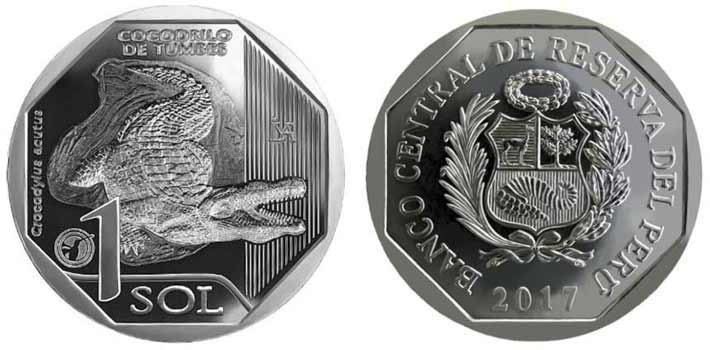
We can find the American crocodile in the Neotropica inhabiting the shores of the Pacific and Atlantic Ocean from northern Mexico and southern Florida down to Venezuela and northern Peru. As the name suggests, in Peru the Tumbes crocodile can be found in the coastal mangroves of Tumbes, mainly in sanctuaries and occasionally in remote areas along the Tumbes river. The grayish-green adults measure on average between 2.90m to 4.10m (9ft6in to 13ft5in) in length weighing up to about 400kg to 500kg (880 lb). They have a triangular, narrow and long head with powerful jaws, short legs and a long powerful tail. Tumbes crocodiles feed on any aquatic or terrestrial animal they encounter.
As only animal of this type living in Peru the Tumbes crocodile is considered vulnerable according to the IUCN (International Union for Conservation of Nature) Red List of Threatened Species. Primary threats include poaching and habitat loss because of coastal developments, including destruction of nesting grounds and the destruction of mangrove swamps.
3rd Threatened Wildlife coin - Andean condor (Condor Andino)
The third coin of the Threatened Wildlife numismatic series was issued on December 13, 2017. It features the Andean condor, scientifically known as vulture gryphus.
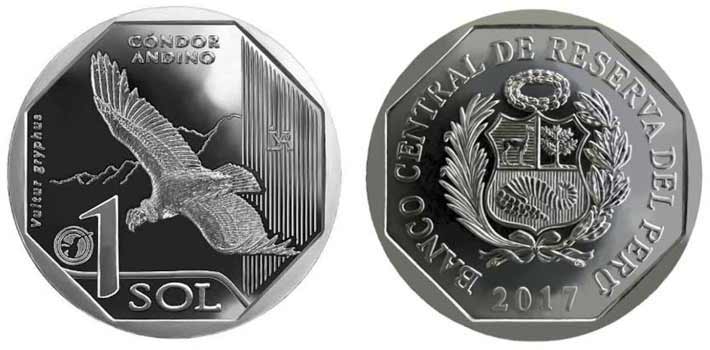
The Andean Condor can be found in the Andes mountains of western South America in windy, open and non-forested grasslands and alpine areas up to 5,000 m (16,000 ft) in elevation, but as well near the coast and coastal deserts that feature good thermal condition. In Peru the best spot to view Andean Condors is the Colca Canyon, the second-deepest canyon in the world located in southern Peru. The massive birds - by combined measurement of weight and wingspan they are considered the largest flying birds in the world – are mostly black, but males have a distinctive white collar around their necks and some white markings on their wings. Feeding mainly on carrion, the majestic Andean Condor performs an important function as a natural clean-up crew.
Playing a fundamental role in the myths and rites of the indigenous Andean people for millennia, today the Andean Condor is considered near threatened by the IUCN (International Union for Conservation of Nature) Red List of Threatened Species. Primary threats include habitat loss, hunting and pesticide poisoning through the food chain.
4th Threatened Wildlife coin - Andean Tapir (Tapir Andino)
The fourth coin of the Threatened Wildlife numismatic series was issued on March 15, 2018. It features the Andean tapir (tapirus pinchaque), also known as mountain tapir, woolly tapir or locally in Peru “tapir de altura” (altitude tapir).
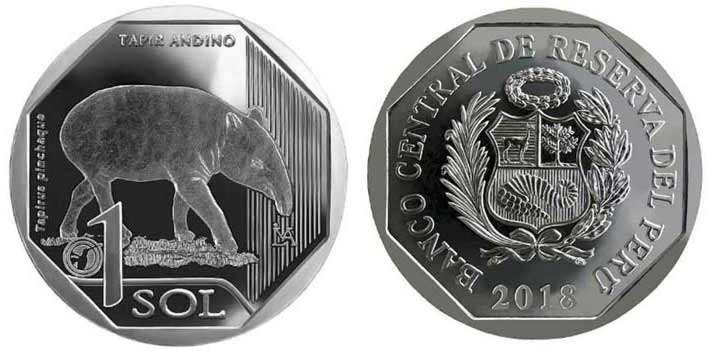
We can find the Andean Tapir in the Andes mountains of Columbia. Ecuador and the far north of Peru in cloud forests and the páramo - neotropical high mountain areas above the continuous forest line, yet below the permanent snowline with a vegetation composed mainly of giant rosette plants, shrubs and grasses. It has blackish-brownish, long and woolly fur and a distinctive white band around the lips. The harmless, shy and solitary Andean Tapir is an herbivore spending its days foraging for food which consists mainly of grasses and shrubs. It plays a key role in a healthy forest, dispersing seeds and eating fresh shoots of plants.
With only 2,500 mountain tapirs left in the wild, the Andean Tapir is considered endangered by the IUCN (International Union for Conservation of Nature) Red List of Threatened Species. Primary threats include habitat loss because of deforestation for agriculture, livestock and mining, and poaching for trade and traditional medicine.
5th Threatened Wildlife coin - White-winged Guan (Pava Aliblanca)
The fifth coin of the Threatened Wildlife numismatic series was issued on June 14, 2018. It features the White-winged Guan (penelope albipennis).
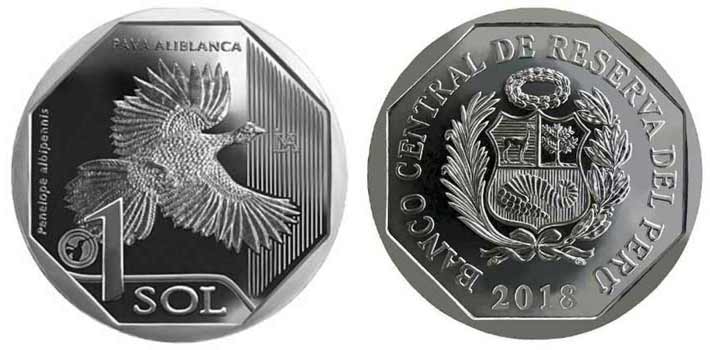
Thought extinct for nearly a century until its rediscovery in 1977, the White-winged Guan is endemic to the foothills of the Tumbes region in north-western Peru and today can be found in the Cajamarca, Lambayeque and Piura regions, where it inhabits dry wooded slopes and ravines. The slender bird with a long neck and tail resembles a turkey and has the size of a large hen. It has dark brown to black plumage with distinctive white patches on the wings. As seed disperser, it plays an important role in a healthy and well-balanced environment.
With only about 200 to 250 white-winged guans left, the Pava Aliblanca is considered endangered according to the IUCN (International Union for Conservation of Nature) Red List of Threatened Species. Primary threats include severe loss of suitable habitat and hunting.
6th Threatened Wildlife coin - Jaguar (Jaguar)
The sixth coin of the Threatened Wildlife numismatic series was issued on October 24, 2018. It features the Jaguar, scientifically known as panthera once and in Peru as otorongo.
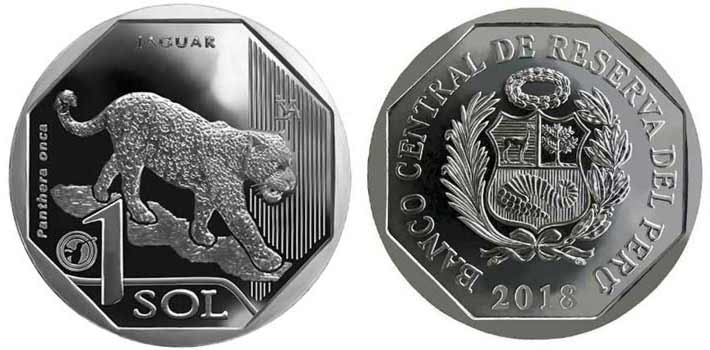
Jaguars are the largest native cat species on the American continent and the third largest in the world. They can be found from Mexico to Argentina in tropical and subtropical dense jungles, dry grasslands and swampy wetlands. In Peru they mainly thrive in protected areas of the Amazon rainforest such as the Pacaya Samiria National Reserve or the Manu National Park. Their fur is usually tan or orange with black spots, called "rosettes", however, about 6% of the Jaguar population has a dark to black fur. Like all cats, jaguars are carnivores feeding only on meat. Being on top of the food chain, they play a crucial role in maintaining a healthy jungle ecosystem by regulating prey populations and thus also regulating the balance of water and plant resources.
With only about 173,000 jaguars left in Latin America from which only 22,000 live in Peru, America’s big cat is considered near threatened according to the IUCN (International Union for Conservation of Nature) Red List of Threatened Species. Primary threats include habitat loss, fragmentation of their habitat, illegal poaching mainly for the trade of their skin, fangs and other body parts and conflicts with farmers.
7th Threatened Wildlife coin - Darwin's Rhea (Suri)
The seventh coin of the Threatened Wildlife numismatic series was issued on December 17, 2018. It features Darwin's rhea (rhea pennata) or lesser rhea, also known in Peru as suri, ñandú de Darwin or ñandú andino.

Darwin’s Rheas can be found in open shrub and grasslands along the Andean plateau from Peru southwards to Patagonia in Argentina. The flightless birds are tall with long legs and a long and thin neck. They are fast runners reaching speeds of up to 60 km/h (37 mph). Their plumage is light brownish to grey and has white spots on the sides. Darwin’s rheas mostly feed of plants, including shoots, seeds, leaves and roots, with the odd insect occasionally.
The very sociable birds are considered as least concern according to the IUCN (International Union for Conservation of Nature) Red List of Threatened Species. Primary threats include habitat loss and fragmentation because of agriculture and hunting for eggs, feathers, meat and “fun”.
8th Threatened Wildlife coin - Yellow-tailed Woolly Monkey (Mono Choro Cola Amarilla)
The eight coin of the Threatened Wildlife numismatic series was issued on March 27, 2019. It features the Yellow-tailed Woolly Monkey, scientifically known as oreonax flavicauda.
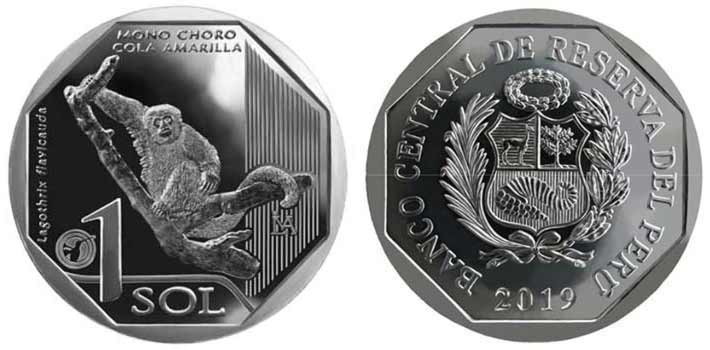
This extremely rare primate species is endemic to Peru and can only be found in montane rain forests and cloud forests of the San Martín and Amazonas regions in the Peruvian Andes at elevations of 1,100m to 2,700m (3,600 – 8,800ft) as well as in smaller areas of La Libertad, Huánuco and Loreto. The deeply mahogany adults with their distinctive long fur and yellow tail tip measure about 52cm (20 inches) in length weighing more or less 8kg (17lbs). The tree-dwelling monkeys are very social and live in large groups. They mainly feed off fruits, flowers and leaves, with the odd insect occasionally.
The Yellow-tailed Woolly Monkey is considered critically endangered according to the IUCN (International Union for Conservation of Nature) Red List of Threatened Species. Primary threats include loss and fragmentation of suitable forest habitat because of deforestation, logging, mining and road construction and poaching and trade as pets.
9th Threatened Wildlife coin - Andean Cat (Gato Andino)
The ninth coin of the Threatened Wildlife numismatic series was issued on July 3, 2019. It features the Andean (Mountain) Cat, scientifically known as leopardus jacobita, which is one of the rarest and least-known wildcats in the world.
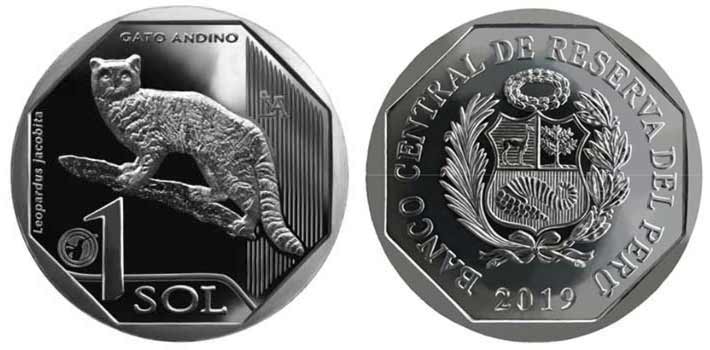
The Andean Cat can primarily be found in rocky and steep terrains in arid and sparsely vegetated areas of the high Andes of Bolivia, Chile and central Peru above the timberline and in the Patagonian steppe. The solitary feline is house cat sized and has an ashy-gray fur with brown-yellowish blotches that are distributed as vertical lines at both sides of the body and a long, thick and fluffy tail with characteristic tail rings. Andean Cats mainly feed off mountain vizcacha and chinchillas.
With only about 1,300 adults left in the wild the Andean Cat is considered endangered according to the IUCN (International Union for Conservation of Nature) Red List of Threatened Species. Primary threats include habitat loss and fragmentation, environmental pollution (water and soil contamination from the mining and petroleum industry), prey reduction and hunting for traditional beliefs, fur and “fun”.
10th Threatened Wildlife coin - Titicaca Water Frog (Rana Gigante del Titicaca)
The tenth and final coin of the Threatened Wildlife numismatic series was issued on November 4, 2019. It features the Titicaca Water Frog (Rana Gigante del Titicaca), scientifically known as telmatobius coleus.
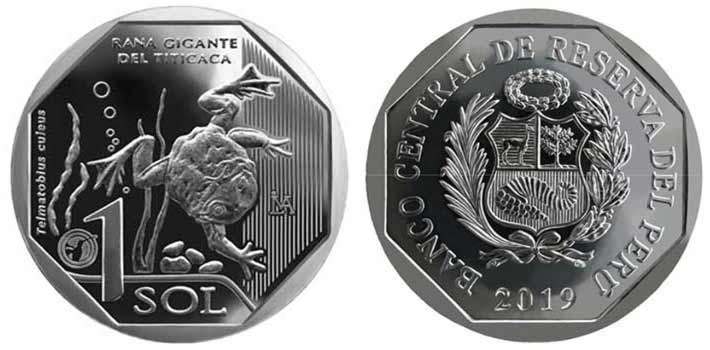
As the name suggests, the Titicaca Water Frog is endemic to the Titicaca Lake of Peru and Bolivia. Growing up to 20cm (8 inches) in length, it’s the world’s largest completely aquatic frog. It spends its days in oxygen-rich waters at the bottom of the lake and does not surface to breathe as it primarily breathes through its skin. Large skin folds, which gave the amphibian its nickname “Titicaca scrotum water frog”, help absorb more oxygen. The Titicaca water frog feeds off amphipods, insects, snails, tadpoles and fish.
With numbers drastically declining over the past five decades the Titicaca Water Frog is considered critically endangered according to the IUCN (International Union for Conservation of Nature) Red List of Threatened Species. Primary threats include habit destruction and contamination, loss of suitable aquatic habitat where reproduction takes place, over-exploitation for human consumption and invasive species.


